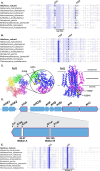This is a preprint.
Involvement of ArlI, ArlJ, and CirA in Archaeal Type-IV Pilin-Mediated Motility Regulation
- PMID: 38562816
- PMCID: PMC10983859
- DOI: 10.1101/2024.03.04.583388
Involvement of ArlI, ArlJ, and CirA in Archaeal Type-IV Pilin-Mediated Motility Regulation
Update in
-
Involvement of ArlI, ArlJ, and CirA in archaeal type IV pilin-mediated motility regulation.J Bacteriol. 2024 Jun 20;206(6):e0008924. doi: 10.1128/jb.00089-24. Epub 2024 May 31. J Bacteriol. 2024. PMID: 38819156 Free PMC article.
Abstract
Many prokaryotes use swimming motility to move toward favorable conditions and escape adverse surroundings. Regulatory mechanisms governing bacterial flagella-driven motility are well-established, however, little is yet known about the regulation underlying swimming motility propelled by the archaeal cell surface structure, the archaella. Previous research showed that deletion of the adhesion pilins (PilA1-6), subunits of the type IV pili cell surface structure, renders the model archaeon Haloferax volcanii non-motile. In this study, we used EMS mutagenesis and a motility assay to identify motile suppressors of the ΔpilA[1-6] strain. Of the eight suppressors identified, six contain missense mutations in archaella biosynthesis genes, arlI and arlJ. Overexpression of these arlI and arlJ mutant constructs in the respective multi-deletion strains ΔpilA[1-6]ΔarlI and ΔpilA[1-6]ΔarlJ confirmed their role in suppressing the ΔpilA[1-6] motility defect. Additionally, three suppressors harbor co-occurring disruptive missense and nonsense mutations in cirA, a gene encoding a proposed regulatory protein. A deletion of cirA resulted in hypermotility, while cirA overexpression in wild-type cells led to decreased motility. Moreover, qRT-PCR analysis revealed that in wild-type cells, higher expression levels of arlI, arlJ, and the archaellin gene arlA1 were observed in motile early-log phase rod-shaped cells compared to non-motile mid-log phase disk-shaped cells. Conversely, ΔcirA cells, which form rods during both early and mid-log phases, exhibited similar expression levels of arl genes in both growth phases. Our findings contribute to a deeper understanding of the mechanisms governing archaeal motility, highlighting the involvement of ArlI, ArlJ, and CirA in pilin-mediated motility regulation.
Figures






References
Publication types
Grants and funding
LinkOut - more resources
Full Text Sources
